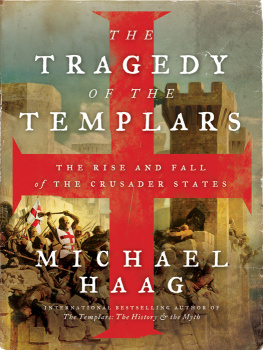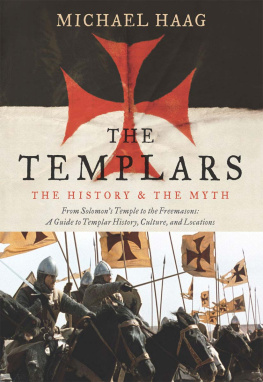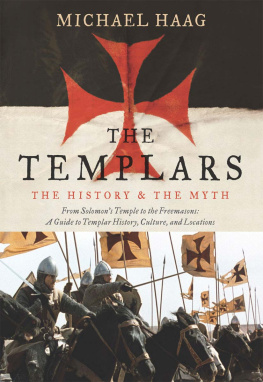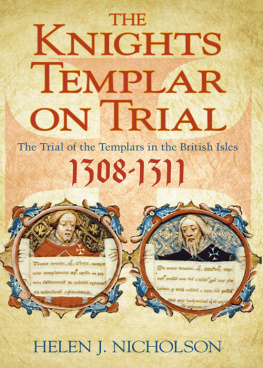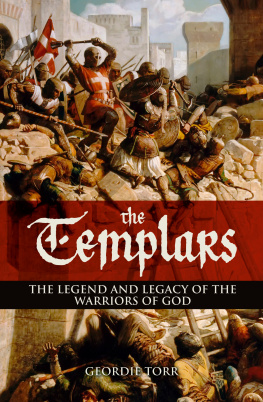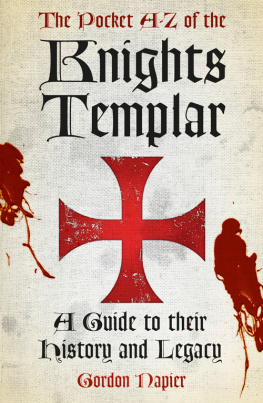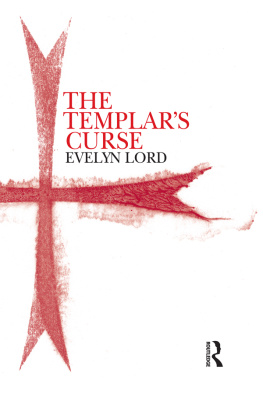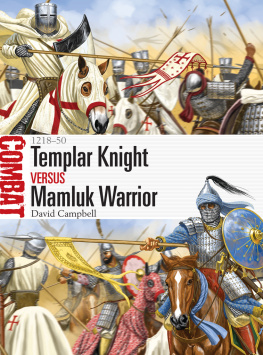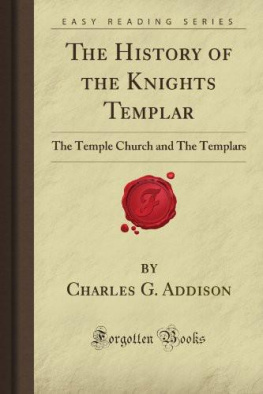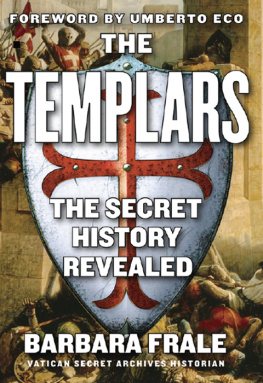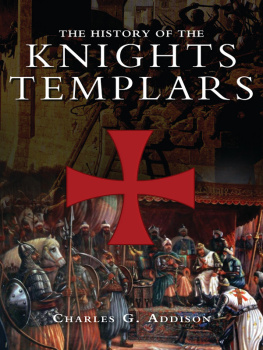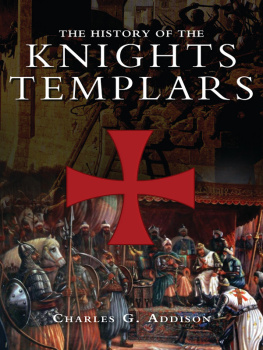
To Neville Lewis
Chevalier of the Inner Temple
and friend of many years
Contents
O N FRIDAY 2 OCTOBER 1187, after a twelve-day siege, and less than a century after the victorious climax of the First Crusade, the inhabitants of Jerusalem surrendered their city under the terms allowed them by Saladin. Those who could afford to pay their ransom were free to walk towards the coast; those who could not pay were to be taken away as slaves. A few Knights Hospitaller were permitted to remain to run their hospital for pilgrims located in the heart of the city adjacent to the Church of the Holy Sepulchre. The knights of the Poor Fellow-Soldiers of Christ were driven out altogether their headquarters had been the Aqsa mosque on the Temple Mount. The Franks believed that the Aqsa mosque had been built on the very site of the Templum Solomonis, as they called it in Latin, and it was not long before the knights became known as the Poor Fellow-Soldiers of Christ and of the Temple of Solomon; or, simply and most famously, the Templars.
Saladins order to purify Jerusalem of the filth of the hellish Franks,
To the Franks of Outremer the land across the sea, as the crusader states were called the fall of Jerusalem was seen as the terrible judgement of God. Saladins capture of the city even suggested to some that Christianity was an inferior belief to Islam. Our people held the city of Jerusalem for some eighty-nine years, wrote the anonymous author of the De Expugnatione Terrae Sanctae per Saladinum. Within a short time, Saladin had conquered almost the whole Kingdom of Jerusalem. He exalted the grandeur of Mohammeds law and showed that, in the event, its might exceeded that of the Christian religion.
Frankish misery was more than matched by Muslim exultation. The victory of Islam was clear, and so was the death of Unbelief,
Yet since 1174, when Saladin became sultan of Egypt and began his independent career, though notionally subject to the Abbasid caliph in Baghdad, he had campaigned against the Franks for barely more than a year; all the rest of his campaigns were directed against his fellow Muslims, whom he defamed as heretics and hypocrites, and who in turn saw him as a dynast who used Islam for his own purposes.
As well as using the propaganda of jihad to make his Muslim rivals submit to his authority or to eliminate them altogether, Saladin also used jihad as an excuse for imposing Muslim rule on Christians, who even at this time were still the majority of the population in Syria, Palestine and Egypt. Jihad is also fought when Islam is in danger, so that when Christians reclaim Christian territory from Muslim occupation, that too can be a reason for jihad. It was a concept that perfectly suited Saladins ambitions, providing religious justification for his imperialist war against Outremer.
Saladin and his army conquered Jerusalem and made war in the Middle East as an alien power alien in religion from the Christian majority and both ethnically and culturally alien from the indigenous Greek-, Armenian-, Syriac- (that is, Aramaic-) and Arabic-speaking population. Saladin himself was a Turkified Kurd who began his career serving the Seljuk Turks, who were invaders from Central Asia, and his army at Jerusalem was Turkish, though with a Kurdish element. just as he destroyed everything he could along the coast, regardless of the welfare of the native population. This was no war of liberation, of reclaiming lost lands; it was the continuance of previous aggression, of Islamic imperialism driven by Saladins dynastic ambitions.
The disaster had been anticipated by the Frankish chronicler William of Tyre, who died in 1186, the year before Jerusalem fell, but who, in recounting how Saladin had begun tightening the noose round the kingdom of Jerusalem with his seizure of Damascus in 1174, analysed why the Franks seemed unable to rise to the threat. The question is often asked, and quite justly, why it was that our fathers, though less in number, so often bravely withstood in battle the far larger forces of the enemy. [...] In contrast to this, the men of our times too often have been conquered by inferior forces. William gave three reasons for this situation. First, our forefathers were religious men and feared God. Now in their places a wicked generation has grown up. The second reason was that, until the advent of Saladin, the Franks in Outremer had enjoyed a long-continued peace with their Muslim neighbours, so that now they were unused to the art of war, unfamiliar with the rules of battle, and gloried in their state of inactivity. But only with his third reason did William of Tyre identify what in fact was the fundamental problem. In former times almost every city had its own ruler, but now all the kingdoms round about us obey one ruler, they do the will of one man, and at his command alone, however reluctantly, they are ready, as a unit, to take up arms for our injury. Not one among them is free to indulge any inclination of his own or may with impunity disregard the commands of his overlord.
But in those autumn days of 1187 after Jerusalem had fallen, neither the faith nor the fighting spirit of the Franks was entirely overwhelmed. The kingdom of Jerusalem had suffered a comprehensive defeat from which no feudal monarchy could have emerged with its powers unimpaired, but the military orders survived and became more important than before. This was particularly true of the Templars, whose single-minded policy and purpose was to preserve, to defend and now to regain Jerusalem and Outremer from the full might of the Turks.

W HEN THE TURKS EMERGED from the steppes of Central Asia and captured Baghdad, they became the masters of what had been an Arab empire. The Turks also became the new champions of Islam, the religion brought by the Arabs when they stormed out from the deserts of Arabia to invade and occupy the fertile lands of the Middle East in the seventh century AD, lands that had been part of the Graeco-Roman world for a thousand years and in the case of Palestine had been home to the Jews for twice as long.
Already since the second millennium BC the Middle East had known the rule of successive rival empires, including the Egyptians, Hittites, Assyrians and Persians. In the early fifth century BC, when the Persians also tried to extend their empire into Europe, they were famously repulsed by the Greeks at Marathon, Salamis and Plataea, and a century and a half later, in 333 BC, when Alexander the Great carried the war into Asia and defeated the Persian king Darius III at the battle of Issus, near the present-day TurkishSyrian border, the entire Middle East came under the rule and cultural influence of the Greeks. By the end of the first century BC the Greeks in turn had been superseded by the Romans, whose empire embraced all the lands round the Mediterranean. This was the world that gave rise to Christian civilisation.
T HE ROMANS RULED PALESTINE through Herod the Great, king of Judea, who constructed the vast platform known as the Temple Mount over a rocky hill to support his gigantic Temple built around 2510 BC on the site of Solomons original Temple of nearly a thousand years earlier. It is Herods Temple that is referred to in the Gospel of Mark 13:12, when a disciple says to Jesus, Master, see what manner of stones and what buildings are here!, to which Jesus replies, Seest thou these great buildings? There shall not be left one stone upon another, that shall not be thrown down. And it was this temple that, duly bearing out the prophecy, was destroyed by the Roman emperor Titus in AD 70 in the course of putting down a Jewish rebellion. During a second Jewish revolt the rebels occupied Jerusalem in AD 132 and intended to rebuild the Temple, even striking coins bearing its image. But the Romans returned in force and crushed the revolt completely. Jerusalem became a pagan city, Colonia Aelia Capitolina. All traces of the Temple were obliterated in AD 135, and statues of Hadrian the conqueror and of Jupiter were erected on the site. Thereafter Jews were forbidden by official Roman decree to enter Jerusalem, although from time to time tacit permission was given for them to enter the precincts of the former Temple. Nothing remained, only the desolate rock, and here the Jews poured libations of oil, offered their prayers and tore their clothes in lamentation.
Next page
